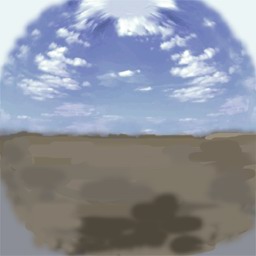Static Environmental Reflections
Description
published mainly for compatibility reason as SuperShader (includes environmental map/fresnel) replacing this functionality
This technology allows show environmental reflections on materials.Environment is static what only changes is only it is lighting accordingly to time of day.Environment is characterized by texture which is called environmental map.In our case environmental map presents hemisphere projection into plane.
Environmental map may looks like this:
For use gradually ensue set of shaders which will use environmental map.
New shader for glass
New shader was made which can work with environmental map.It's used for glass sheets.On input it has besides environmental map also lookup texture for fresnel equations.Is it possible to generate fresnel texture inside TexView2 with use of code. Yet it is easier to use procedural texture.
#(ai,64,64,1)fresnelGlass()
In this case is used index of refraction 1.7 - common glass. It's possible to enter it as parameter:
#(ai,64,64,1)fresnelGlass(1.9)
Whole material for glass may look like this (it's good in future use second pass - here it is left out only for simplicity):
renderFlags[]={NoAlphaWrite};
specular[]={1,1,1,0};
specularPower=5;
PixelShaderID="Glass";
VertexShaderID="Glass";
class Stage1
{
texture="#(ai,64,64,1)fresnelGlass()";
uvSource="none";
};
class Stage2
{
texture="env_co.tga";
uvSource="none";
};
If very low value (0) appears inside alpha within basic glass texture then whole texel cease to draw (nothing will reflect in that spot and it will look like hole in glass).
Imaging formula
Specular portion of imaging formula equation got following form:
,where ligthS is light color, envS is value from environmental map, matS is specular value from material, tD is value of basic (diffuse) texture.
IOR table
| MATERIAL | Index |
| Vacuum | 1.00000 (exactly) |
| Air (STP) | 1.00029 |
| Acetone | 1.36 |
| Alcohol | 1.329 |
| Amorphous Selenium | 2.92 |
| Calspar1 | 1.66 |
| Calspar2 | 1.486 |
| Carbon Disulfide | 1.63 |
| Chromium Oxide | 2.705 |
| Copper Oxide | 2.705 |
| Crown Glass | 1.52 |
| Crystal | 2.00 |
| Diamond | 2.417 |
| Emerald | 1.57 |
| Ethyl Alcohol | 1.36 |
| Flourite | 1.434 |
| Fused Quartz | 1.46 |
| Heaviest Flint Glass | 1.89 |
| Heavy Flint Glass | 1.65 |
| Glass | 1.5 |
| Ice | 1.309 |
| Iodine Crystal | 3.34 |
| Lapis Lazuli | 1.61 |
| Light Flint Glass | 1.575 |
| Liquid Carbon Dioxide | 1.20 |
| Polystyrene | 1.55 |
| Quartz 1 | 1.644 |
| Quartz 2 | 1.553 |
| Ruby | 1.77 |
| Sapphire | 1.77 |
| Sodium Chloride (Salt) 1 | 1.544 |
| Sodium Chloride (Salt) 2 | 1.644 |
| Sugar Solution (30%) | 1.38 |
| Sugar Solution (80%) | 1.49 |
| Topaz | 1.61 |
| Water (20 C) | 1.333 |
| Zinc Crown Glass | 1.517 |


